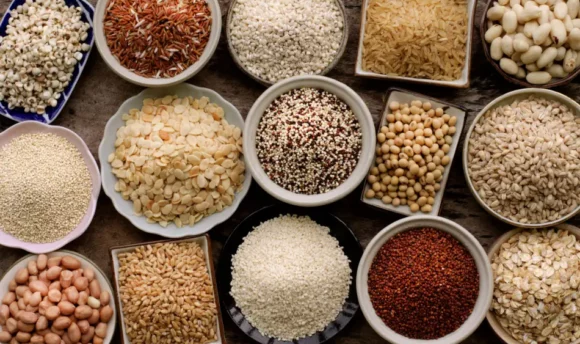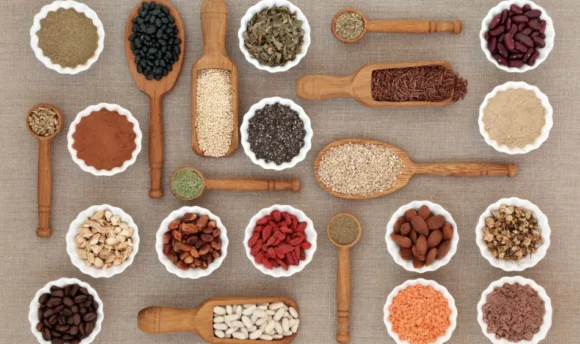Is Falafel Healthy? Nutrition Facts and Health Benefits

From food trucks to fine dining restaurants, falafel is a savory snack loved around the world for its crunchy exterior and moist, flavorful interior. What’s more, these deep-fried, crunchy balls or patties are the perfect option to satisfy your sudden cravings.
But have you ever wondered if falafel is good for you? Is it a healthy choice or just another guilty pleasure?
To answer all your questions, we will explore the nutritional facts and health benefits of falafel so you can make an informed decision the next time you are faced with the tempting choice of this aromatic snack.
Is Falafel Healthy?
The star ingredient in falafel is fava beans or chickpeas (garbanzo beans), which are high in protein, soluble fiber, and complex carbohydrates. This makes it a brilliant choice for vegetarians or vegans in need of a plant-based protein option.
In addition, falafels contain a modest amount of sodium, antioxidants, and vitamins and minerals, such as iron, magnesium, and phosphorus, which can help maintain blood sugar levels, promote satiety, and provide sustained energy.
The only drawback is that falafel is traditionally deep-fried, which increases its calorie and fat content. However, this can be easily overcome by baking or grilling falafels instead of frying them.
What Is Falafel?
Packed with essential nutrients, proteins, and vitamins, falafel is a flavorful food that has its roots in the Middle East. Though the exact origin is somewhat disputed, with both Egypt and Israel claiming to have invented the dish, falafel has been a staple of Middle Eastern cuisine for centuries.
These flavorful balls or patties are made from soaked and ground chickpeas, fava beans, or a mixture of both. Meaning it is loaded with a healthy dose of plant-based protein, soluble fiber, and complex carbs. It also contains a combination of flavorful spices and fresh herbs, making it a scrumptious entree choice for meatless eaters.
While falafel can be a very satisfying meal on its own, it is commonly served in flatbread, a pita pocket, or as a filling for shawarma alongside a variety of fresh crunchy veggies, such as tomatoes, lettuce, cucumbers, hummus, tahini sauce, etc.
5 Health Benefits of Falafel
Falafel is a toothsome food made using a handful of nutritious ingredients that offers a wide array of health benefits. From being rich in fiber to protein, and essential nutrients, here’s what makes these fried patties a perfect snack to consider, even when you are on a diet.
#1 Protects your heart
Falafels are made of chickpeas, a plant-based protein that is low in cholesterol and doesn’t contain trans or saturated fats.
In a study, chickpea supplementation was found to reduce the levels of two biomarkers of cardiovascular diseases – serum cholesterol and low-density lipoprotein cholesterol (LCL-C).
In addition, a diet rich in legumes also helps lower systolic blood pressure, thereby reducing the risk of cardiovascular conditions.
#2 Good for diabetes
Falafel is a low glycemic index (GI) food (GI of 55 or less). Meaning it doesn’t cause a rapid rise in blood sugar levels. According to a study, a serving of falafel with pita bread, pickled vegetables, salad, and tahini sauce, only had an average GI of 33.
What does this mean for people with diabetes?
According to research, the chickpeas in falafel help regulate glucose and insulin levels, which is particularly great for people with prediabetes and diabetes.
Furthermore, researchers in another study found that chickpea consumption reduced blood glucose concentration in participants by 29–36%. This can be an attribute of the fiber content that slows carb absorption and thereby helps manage blood sugar levels.
#3 Lowers risk of colon cancer
Though chickpeas or fava beans are the star ingredient in falafels, the food also contains a good amount of garlic.
Garlic has been shown to have therapeutic effects in cancer treatment. Based on clinical studies, it can provide relief from concerning conditions in various cancer types, including colorectal, breast, lung, and pancreatic cancers.
#4 Improves bowel movements
Falafel has a higher fiber and complex carbohydrate content, which are essential for good digestive health. These substances promote regular bowel movements, increase the frequency of defecation, soften the stool composition, and help prevent constipation.
#5 Lowers cholesterol
The recommended daily intake of fiber is 25–38 grams per day. 4 ounces of legumes, including chickpeas or fava beans, contain around 7–9 grams of fiber. Hence, 5–6 falafels can help you meet the daily fiber requirement, which can, in turn, lower your total low-density lipoprotein (LDL) or bad cholesterol levels.
Possible Side Effects of Falafel
While falafel is a tasty and nutritious snack, it does come with a few adverse effects.
To begin with, eating falafel when cooked in a lot of oil is unhealthy, as it contains a higher calorie and fat content. Studies have consistently proven that people who regularly consume deep-fried foods are at higher risk of cardiovascular diseases, obesity, diabetes, and cancer.
Furthermore, some people might be allergic to the ingredients that go into or are served with falafels, such as sesame seeds and chickpeas.
Sesame seeds, the main ingredient used to make tahini sauce served with falafel dishes, are the US’s 9th most common food allergen. In addition, some people might also be allergic to chickpeas. Hence, consuming falafels can lead to severe allergic reactions in such people.
Lastly, store-bought falafels or those ordered from restaurants often contain high sodium. This can be a major drawback for people on heart medications or following a low-sodium diet.
Nutrition Facts of Falafel
A 100g serving of falafels includes 6 small patties or balls and is loaded with several nutrients, and contains about 333 calories. According to the United States Department of Agriculture (USDA) FoodData Central, the nutritional content of falafels per 100g is as follows:
Nutritional value (per 100g)
| Calories/Nutrient (per 100g) | Amount |
| Calories (kcal) | 333 |
| Net Carbs (g) | 31.8 |
| Fiber (g) | 4.9 |
| Sugar (g) | 0.6 |
| Fats (Total) (g) | 17.8 |
| Saturated Fats (g) | 2.38 |
| Calcium (mg) | 54 |
| Protein (g) | 13.3 |
High in plant protein
Chickpea falafel is an excellent source of vegetable protein. Per 100g serving (or 5 patties), it contains approximately 13.3g of protein. This makes it a perfect choice for vegetarians, vegans, or anyone looking to increase their protein intake without eating meat.
High in fiber
Falafels are high in fiber, with approximately 1g of fiber per 100g serving. This fiber helps promote regular bowel movements, improves satiety, and slows the absorption of carbohydrates, reducing the risk of conditions such as constipation and diabetes.
Rich in potassium and phosphorus
Regarding micronutrients, falafels contain a good amount of potassium (585mg) and phosphorus (192mg). Phosphorus promotes strong bones and teeth, while potassium aids fluid regulation, helps regulate blood pressure, and supports proper nerve function.
Good source of B vitamins
Finally, the chickpeas in falafels contain important vitamins, including vitamin B, niacin, riboflavin, thiamin, folate, and beta-carotene. These vitamins are essential for overall health and especially important for pregnant women to support the healthy development of the fetus.
How to Make Healthy Falafel at Home
While falafel does have some potential side effects, it can be easily avoided by making this tasty snack at home. For example, you can use whole-wheat or chickpea flour instead of refined flour, avoid adding too much salt, use minimal oil, and bake the falafels instead of frying them.
Here’s how to make falafel healthier and tastier.
Ingredients:
- 1 can chickpeas, drained and rinsed
- 1 small onion, finely chopped
- 2 garlic cloves, minced
- ½ cup chopped fresh parsley
- ½ cup chopped fresh cilantro
- 2 tbsp whole wheat flour
- 1 tsp ground cumin
- ½ tsp ground coriander
- ½ tsp smoked paprika
- ¼ tsp cayenne pepper
- Salt and freshly ground black pepper to taste
- 1 tbsp lemon juice
- 1 tbsp olive oil
Instructions:
- Preheat the oven to 375°F (190°C). Grease a baking sheet with oil and set aside.
- In a food processor, pulse the chickpeas, onion, garlic, parsley, and cilantro until finely chopped.
- Add the flour, cumin, coriander, paprika, cayenne pepper, salt, and black pepper to the food processor and pulse until well combined.
- Add the lemon juice and olive oil and mix briefly.
- Scoop the mixture into small patties and place on the prepared baking sheet.
- Bake for 15–20 minutes or until golden brown and crisp.
- Serve warm with your favorite dipping sauce or wrapped in pita bread with hummus, lettuce, tomato, and cucumber.
FAQs
Yes, falafel is a good source of plant protein. In addition, it is also rich in complex carbohydrates and fiber.
The number of calories in a falafel can vary based on the recipe. However, on average, a falafel ball contains around 57–65 calories, and a 100-gram serving (6 patties) has about 333 calories.
Falafel is a good source of protein, as well as essential nutrients. However, when deep-fried, they also tend to be high in fat and calories. Hence, if you bake or grill your falafels at home, you can eat them daily. Otherwise, it is recommended to eat falafel occasionally.
Being rich in protein and iron, falafels make an excellent substitute for meat options. They are also lower in saturated fat and high in fiber, and falafel’s nutritional profile stacks against red meat.
A Word From a Nutritionist
Falafels are a healthy and tasty source of plant-based protein, made with ground chickpeas or fava beans and a combination of herbs and spices. These fiber-rich balls or patties offer a wide range of health benefits. They help regulate blood sugar levels, lower cholesterol, and promote healthy digestion.
However, falafel is fried, which makes it less suitable for daily consumption, especially if you’re at higher risk for cardiovascular disease, diabetes, or obesity. In addition, fried falafel from restaurants may contain added sodium, other preservatives, or allergens.
The good news is that you can eat homemade falafel to avoid adverse effects. For example, air frying or baking falafels instead of deep frying them, avoiding excessive salt, and modifying the recipe to avoid allergens like sesame seeds can make this delicious food a great addition to a balanced, healthy vegan diet.
Conclusion
Rich in plant protein, fiber, and various vitamins and minerals, falafel is a healthy and flavorful snack. However, falafels available at restaurants are usually deep-fried and, therefore, high in fat and calories. Hence, you must consume them in moderation.
On the bright side, you can easily make less oily and more nutritious baked falafel at home with a little effort. Remember to keep an eye on the portion size, and enjoy it with a side of hummus or tahini sauce.

















































 Select your language:
Select your language: 







